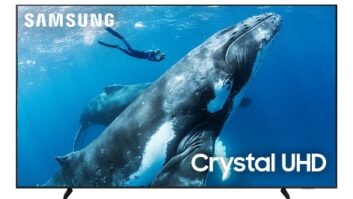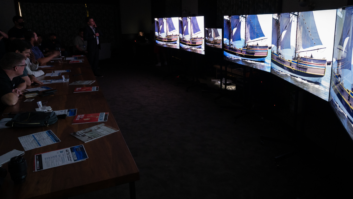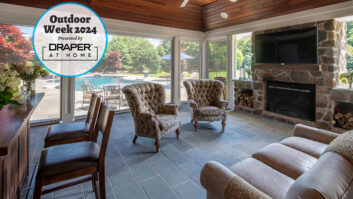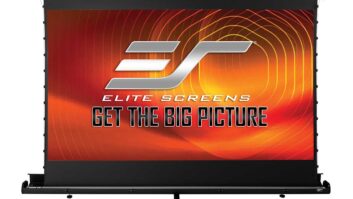The technology behind the key product categories in our industry often appear to change overnight. At the same time, other product categories seem to move at a glacial pace. More puzzling, however, is when a new disruptive technology crashes onto the scene, yet fails to unseat an old standby that remains viable much longer than anticipated.
A collision of these disparate time frames is best exemplified in the display technology arena. There has been a good deal of activity in the category, with the spread of DLP, LCD, and LCoS microdisplay light engines, all of which are pushing CRT technology out of the front-projection market. Similarly, fixed-pixel products, such as LCD and plasma display panels (PDP), have built momentum and are poised to do the same thing to CRT in the direct view display market, where LCD and PDP are the sole contenders in the 37-inch and up size category. Yet, even as its marketshare is declining in the mid-size direct-view market, CRT continues to remain viable, while LCD is still too expensive for some applications.
Indeed, CRT, an ancient technology by todays standards, is bringing new techniques to bear. Through the development of slim tubes that employ advanced manufacturing techniques, manufacturers are able to produce full HD-capable CRT-based direct view sets at 30 inches that are not much deeper than a flat panel and with a lower price point.
Even more interestingly, just as the (relatively) new technologies are settling into a comfortable marketshare, newer innovations such as OLED, SED, and nano-tube technology are waiting in the wings. As LCD and PDP attempt to put the final nails in CRTs coffin, they have their sights set on the current upstarts. No matter how far out in the distance it may be, you need to have answers to questions about the crop of new display offerings when they are raised by clients, prospects, or that pesky neighbor always looking to you for expert advice.
SED. Surface-Conduction Electron-Emissive Display (SED), which uses individual micro-emitters printed on a backplane that act in the same manner as electron guns to light up the individual pixel cells on a phosphor-coated front face glass panel, is the classic definition of a disruptive technology. Talked about in the press and demonstrated to dealers for more than a year, it has been shown to have great potential. SED has great contrast, a wide viewing angle, fast response time, relatively low power consumption, and in the long run has the potential to take advantage of improved printing-based manufacturing to make good on its promise.
However, as of CES in January, SEDs introduction date has been pushed back to some time in early 2007. As the year progresses, marketplace pressure from a technology upswing to 1080p and plasma, as well as continued downward price pressure for all forms of flat-panel and projection displays may make it harder for SED to become the breakthrough technology that it has been touted to be.
At the same time, other technology companies, both large and small, including Motorola, are working behind the scenes on nano technology-based displays. But other than being a technology core within SED, it seems a bit too early to talk about Carbon Nano Tube (CNT) technology in depth.
OLED. In a similar vein, a variety of flat-panel display technologies have emerged from within the OLED family. They are used for information and video display in cell phones and aftermarket head units, with manufacturers such as Samsung demonstrating OLED-based displays up to 40 inches. But just as with SED, the jump from a few technology demonstration units at a trade show to mass-scale production is a big one. It is too early to tell if OLED will make a dent in the direct view market.
LED. Take the O out of OLED and you have a completely different story. LEDs have been around for years, but their use in video displays to date has been restricted to large-venue and outdoor displays. However, in the past year the availability of high light output LEDs has considerably changed the ways in which they may be put to use in both direct view and projection displays.
Continuing for the moment with our description of direct view displays, LEDs have been demonstrated as the light source for LCD panels, either totally replacing or augmenting the cold cathode fluorescent lamp (CCFL) tubes that have long been the mainstay for LCD. Replacing the CCFL with LED gives the promise of a greatly improved color gamut, faster response times, the elimination of environmentally unfriendly mercury-based coatings, lower power consumption, and longer life for the backlight system. At first glance, it is easy to imagine that the LED array would have a single LED for each pixel, but that is not practical at this time. Rather, high-light output LEDs are sealed in a light-guide assembly that is then matched up with the LED panel.
For the moment, LED backlighting is one of those great ideas, demonstrated and offered in high-end products such as the 82-inch panels shown by Sony and Samsung, but is not yet in widespread production. If it is something that you can demonstrate, by all means do so, but remind consumers asking for it in more affordable products and more practical screen sizes that LED illumination for LCD direct view panels may turn out to be another great definition of hurry up and wait.
In the mean time, use the talk about LED backlighting of displays to give your customers a better understanding of how the broader LCD panel system works, and jump from there to an explanation of how many manufacturers are making significant improvements to the performance of CCFL lighting systems as a way to differentiate the products that you sell from those of competitors and second- or third-tier brands.
Closer in, from a time-frame perspective, is the application of high light output LEDs to illuminate the micro display chips that are used in front and rear projectors. Particularly with single-chip DLP products, but also in three-chip LCD and LCoS and LCoS-derivative technologies such as D-ILA and SXRD, LED holds the promise of eliminating costly lamp replacements. More importantly, replacing a single UHP lamp and a spinning color wheel with three-LEDs as the light source for DLP projection engines has the key benefit of doing away with the spinning color wheel that creates rainbow artifacts that some consumers simply cant ignore.
First shown in a mini-sized pocket projector at last years InfoComm, LED illumination for DLP rear projectors hit the mainstream at CES 2006 with Samsung, Akai, and others debuting displays with the technology. NuVision launched its 52-inch model at EHX in March and JVC has demonstrated the technology in a prototype D-ILA-based unit. At this point in time the use of LEDs for projection engines is as much of an exotic differentiation as anything else, as pictures certainly were free of rainbow effects and had improved color rendition, but seemed to lack the snap of conventionally illuminated systems. Nevertheless, demands for more energy efficient lighting for all applications are driving LED research. That will make sense for projection televisionbut perhaps not quite yet, and at pricing that may carry a premium for another product cycle.
Lasers. Perhaps the true holy grail for projection systems is to use lasers as the light source. Recently, Mitsubishi executives put it all on the table by announcing that they will have a laser-based rear projector ready for market in the fall 2007 selling season. The laser-illumination system will use three laser emitters that each focus a diffused single color light across the surface of a single DLP chip rather than use the color wheel to divide the colors as is done today. Promised benefits of lasers in combination with DLP include the possibility of thinner cabinets, brighter pictures, improved color, contrast and scalability that makes the technology applicable to a wide range of screen sizes.
While the mock-up of a laser-based unit was, indeed, thin and elegant, with marketplace availability still more than 20 months away, it is unfair to judge what the final picture quality will be based on the early-stage engineering mule sample that was at the line show. As a proof-of-concept display there was no doubt that the technology works, but that work is still very much in progress.
GLV. As proof that seemingly disruptive technologies dont always disrupt, it is worth pointing out that lasers are also part of the light engine for Grating Light Valve (GLV) projection systems. Promoted a few years ago as yet another breakthrough technology for the future, this is one where the promise remains, but practical application for anything below the level of a multi-million dollar flight simulator or an extreme large-venue installation is probably further off in the distance now than it was when the technology was first promoted as a competitor to DLP and D-ILA in the digital cinema market. You can buy a laser-illuminated GLV-based projector now, just be prepared to shell out a kings ransom.
Six-Color Color Wheels. Closer to current application, this year will see the first production of rear-projection products utilizing six-color color wheels either in a generic application of Texas Instruments reference design or in proprietary extensions from individual manufacturers. In brief, the variations to date in the color wheels that are essential to the operation of single-chip DLP systems break light up into the standard red, blue, and green components, with some color wheels adding a fourth, clear segment to the color wheel. When you hear talk of six segment or nine segment arrangements, the key word is segment. To improve color, and to some extent to provide product differentiation, those color wheels keep the same number of colors, but simply speed up the wheel and associated electronics that present the image frames to the DLP. As a result rather than a red/blue/green segmented filter wheel you have repetition that, for example, in a six-segment wheel you have a red/blue/green/red/ blue/green arrangement on a single disc.
With this new approach, the major change is not the number of segments but the number of colors that those segments filter. Thus, rather than only separating the light into red, blue, and green, you have the additional subdivision into yellow, magenta, and cyan as secondary colors for a total of six. With the appropriate video signal processing to power this, you are able to create a broader color palette and brighter pictures since each of the color components gets a full shot at the light source.
Mix-and-Match. While each of these technologies may seem to be independent of one another, there are some closer in applications that mix them together for interesting combinations. For example, it is possible to have a hybrid LCD backlight that combines the benefits of a fuller spectrum CCFL with an LED assist. Further down the line, it is not out of the question to see some of these technologies combined. Given enough time, research effort and development budgets, one supposes that there is no reason why you couldnt combine the multi-color technology approach, with LED or laser-based illumination to combine the benefits of each technology.
In another direction, the idea of going beyond the traditional RGB color breakdown is something that has been demonstrated for both micro display projection and LCD direct view panels by Genoa Color Technologies, an Israeli semiconductor company that offers RGBY- and RGBYC-based solutions for multiple chip micro display projectors and similar technology that could be integrated with direct view displays by adding either yellow and both yellow and cyan sub-pixels to an LCD panel.
For the moment the real key remains no different than our traditional mantra: be able to explain what you have today and why it will serve the client well in the long term, while at the same time keeping a watchful eye out for what is approaching, and when it will logically reach the market coupled with an understanding of how they compete with what you have now and what your competitors lines offer today. If the equation doesnt work out for the latter, be prepared to ask your current vendors to defend their technology from a price/benefit/competitive view standpoint, and, without threatening, be ready to change vendors or at least add another line if that seems to be the right decision.
Not all new technologies are disruptive, and not all disruptive technologies are new. They can put you out of business if you bet too heavily on the wrong one, but hedging your bets isnt such a bad idea, as the few people who still sell CRT-based front projectors will testify. Having gotten through the technology side of the display world, the next step is to see how all of this settles down into near-term products for this fall.







